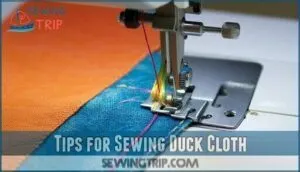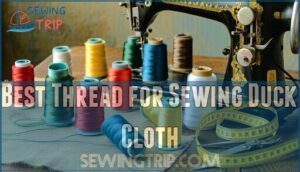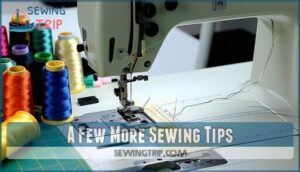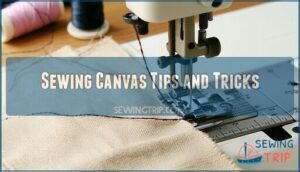This site is supported by our readers. We may earn a commission, at no cost to you, if you purchase through links.

Set it between 5 and 7 for a smooth stitch.
Use heavy-duty needles to prevent breakage, and adjust thread tension as needed.
Reinforced stitching methods will also help.
By getting these basics right, you’ll be sewing like a pro in no time.
Now, let’s get into the nitty-gritty of sewing with duck cloth and explore more tips to guarantee your projects turn out perfectly.
Table Of Contents
- Key Takeaways
- What is Duck Cloth?
- Tips for Sewing Duck Cloth
- Best Thread for Sewing Duck Cloth
- What Size Sewing Machine Needle for Duck Cloth?
- Sewing Machine Tension for Duck Cloth
- Do You Wash Duck Cloth Before Sewing?
- Duck Cloth Sewing Projects
- Some Advantages of Using Duck Cloth
- A Few More Sewing Tips
- Sewing Canvas Tips and Tricks
- Frequently Asked Questions (FAQs)
- Conclusion
Key Takeaways
- Set your sewing machine tension between 5 and 7 for smooth stitches when working with duck cloth.
- Use a 100/16 jeans needle to handle the fabric’s thickness and prevent skipped stitches or breakage.
- Prewash duck cloth to soften it and reduce shrinkage, and make sewing easier.
- Choose heavy-duty polyester or nylon thread for strength and durability, especially for outdoor or heavy-use projects.
What is Duck Cloth?
Duck cloth, a heavyweight fabric with a tight weave, has a rich history of durability. Originally used for sails and sailor pants, it’s now popular in upholstery, outdoor gear, and sturdy clothing.
A rugged fabric with timeless durability, duck cloth is perfect for creating strong, stylish, and long-lasting projects.
Its plain weave and subdued colors make it both practical and stylish. Duck cloth weight varies from light 4-ounce to heavy 20-ounce options, perfect for different projects.
Its toughness resists wear and tear, softening with use. To accelerate this process, you can explore methods to soften the fabric.
If you need fabric that’s built to last, duck cloth is your go-to option for projects that require a strong and long-lasting material.
Tips for Sewing Duck Cloth
Working with duck cloth can feel like taming a wild horse, but it’s manageable with the right approach.
Start by pre-washing to soften the fabric and reduce fraying. Use a 100/16 jeans needle—the best needle for duck cloth—to handle its thickness. Adjust your sewing machine tension using a needle tension guide to prevent puckering.
For sewing thicker fabrics, consider using a jeans presser foot for better control.
Keep these tips in mind:
- **Choose sturdy threads for durability.
- **Clip layers instead of pinning to avoid damage.
- **Press seams flat for neat finishes.
- **Reinforce stress points for longevity.
Best Thread for Sewing Duck Cloth
Choosing the right thread can make or break your duck cloth sewing project.
Polyester or nylon threads are your go-to for strength and flexibility, especially when sewing thick fabric. Outdoor thread durability is key for heavy-duty sewing, while thread weight matters for stitch balance. Don’t forget to match your thread color to your fabric for a polished finish.
Here’s a quick guide:
| Thread Type | Best Use | Durability | Key Feature |
|---|---|---|---|
| Polyester | Everyday projects | High | Smooth and strong |
| Nylon | Outdoor items | Very High | Weather-resistant |
| Cotton-covered Poly | Light-duty sewing | Medium | Soft texture |
| Bonded Polyester | Rugged applications | Extreme | Water-resistant |
Thread fiber types and sewing machine tension adjustments guarantee smooth stitching every time!
What Size Sewing Machine Needle for Duck Cloth?
Getting the right needle size for duck cloth is vital for smooth sewing.
Use a 100/16 jeans needle for most projects—it’s sharp, sturdy, and ideal for heavy fabrics.
Here’s a quick guide to help:
- Match needle size to fabric weight—heavier cloth needs thicker needles.
- Consider needle point types—jeans needles reduce skipped stitches.
- Test universal needle alternatives—confirm compatibility with your machine.
- Watch for hole size effects—larger needles can leave visible marks.
Using the correct jeans sewing product will improve your sewing results.
Proper needle selection guarantees strong, clean stitches every time!
Sewing Machine Tension for Duck Cloth
Getting the sewing machine tension just right for duck cloth can feel like threading a needle in dim light, but it’s easier than you think.
Start by matching your thread weight and needle size to the fabric’s thickness. A 100/16 jeans needle and heavy-duty polyester thread are great choices.
Adjust the tension settings gradually. For duck cloth sewing, a tension of 5-7 usually works well, but always test on a scrap first. Understanding sewing machine products can help you achieve superior results. Keep an eye on stitch appearance—loose stitches mean you need to tighten the upper tension, while puckering calls for loosening it slightly.
Here’s a quick guide:
Setting Recommendation
**Why?
| ** | ||
|---|---|---|
| Thread Weight | Heavy-duty polyester | Reduces breakage |
| Needle Size | 100/16 jeans needle | Pierces dense fabric easily |
| Presser Foot Pressure | Medium to high | Guarantees smooth feeding |
Tension troubleshooting takes patience, but once balanced, your seams will hold like a charm!
Do You Wash Duck Cloth Before Sewing?
Prewashing duck cloth is a smart move to tackle shrinkage concerns and guarantee your project turns out just right.
Prewashing duck cloth prevents shrinkage, softens the fabric, and ensures your project starts on the right foot.
Since this fabric is prone to fabric shrinking—up to 8-10%—it’s best to wash it before cutting your pattern pieces.
Use cold water on a gentle cycle, and skip the detergent if the cloth has waterproofing treatments.
Air drying is ideal to avoid damage and maintain fabric integrity.
Prewashing also softens fabric, making it easier to sew and preventing fraying during assembly.
To minimize fraying, consider cutting corners diagonally before washing.
Overlock the raw edges beforehand to keep them neat.
For wrinkle removal, dampen the cloth slightly and use a high-heat iron setting, but avoid fully drying it for easier pressing.
Be mindful of color bleeding, especially with bright or deep shades, and always test on scraps first.
A little preparation goes a long way toward professional-looking results!
Duck Cloth Sewing Projects
Duck cloth projects are perfect for creating durable, stylish items.
Whether you’re sewing thick fabric for practical use or creative flair, here are some ideas:
- Bag Designs: Craft sturdy tote bags or backpacks with reinforced seams.
- Home Decor: Make pillow covers, curtains, or upholstery for a rustic touch.
- Outdoor Gear: Design tool rolls, aprons, or camping gear.
- Apparel Ideas: Try jackets, overalls, or heavy-duty pants.
- Quilting Projects: Combine duck cloth with softer fabrics for unique quilts.
Get creative and make something that lasts!
Some Advantages of Using Duck Cloth
Duck cloth is a powerhouse fabric, offering durability, weather resistance, and cost effectiveness for countless projects.
Its natural fibers make it versatile for sewing thick fabric items like bags or upholstery, while resisting fraying and wear.
Plus, it softens beautifully over time without losing strength.
| Duck Cloth Advantages | Why It Matters | Best Uses |
|---|---|---|
| Durability | Extends project lifespan | Bags, aprons, upholstery |
| Weather resistance | Handles outdoor conditions | Tents, tarps, outdoor gear |
| Cost effectiveness | Budget-friendly durability | Curtains, crafts, home décor |
| Natural fibers | Eco-friendly and breathable | Apparel, quilts, accessories |
| Versatility | Adapts to many designs | Pillows, totes, décor schemes |
A Few More Sewing Tips
Perfecting your stitches with duck cloth doesn’t have to feel like wrestling with a stubborn fabric. A few smart tweaks can make sewing thick fabric a breeze.
Here’s how to keep things smooth:
- Mind your tools – Use a sturdy 100/16 needle and strong thread, like polyester or cotton-covered polyester. These handle the demands of duck cloth without breaking a sweat. Pattern weights can help keep your cutting layout precise.
- Tension matters – Sewing machine tension and needle tension are your best friends here. Start with a moderate setting (around 5-7) and adjust slowly to avoid puckering or thread breakage. Test on scraps to find that sweet spot.
- Work smarter, not harder – A walking foot attachment keeps layers from slipping, while pressing techniques like flattening seams with a clapper reduce bulk. For beginners, woven fabrics are easier to handle, making them ideal for practice. Fabric stabilizers can also make tricky areas more manageable.
Small tweaks, big difference!
Sewing Canvas Tips and Tricks
Sewing canvas can feel tricky, but with the right tips, you’ll breeze through it like a pro.
From prepping your fabric to adjusting your machine, a few simple tweaks make all the difference.
What is Canvas Material?
Canvas, a close cousin of duck cloth, is a timeless, heavy-duty fabric known for its durability and versatility.
Its tightly woven structure, or canvas weave, makes it ideal for rugged projects like bags, outdoor furniture covers, and even upholstery.
Canvas fabrics come in various types, weights, and textures, offering endless creative possibilities, with a particular emphasis on its strength and long-lasting appeal, whether sewing canvas material for décor or gear.
Need More Similar Ideas?
If you’re craving more sewing inspiration, why not explore projects beyond duck cloth.
Canvas is versatile and perfect for creative ventures. Here are five ideas to spark your imagination:
- Upholstery Projects: Refresh chairs or ottomans with durable canvas.
- Outdoor Covers: Protect furniture with weather-resistant canvas.
- Custom Tote Bags: Add pockets or unique designs for flair.
- Wall Art: Stretch painted canvas over wooden frames.
- Tool Rolls: Organize tools with sturdy, stitched compartments.
Experiment with sewing machine tension, needle size, and advanced techniques for polished results!
Q&a About Sewing Canvas You Might Find Useful
Ever wondered about canvas weight or project suitability? Heavier canvas fabrics need industrial machines, while lighter ones work with home setups.
Adjust sewing machine tension and use sturdy sewing machine needles for clean seams. For seam finishes, try zigzag stitches or binding tape.
Pre-washing helps with fabric softening and pattern adjustments, ensuring your duck cloth projects are smooth from start to finish.
Prepping for Sewing With a Basic Sewing Machine
Getting your sewing machine ready is key to tackling duck cloth or canvas projects.
Start by ensuring needle compatibility and adjusting sewing machine tension for thicker fabrics.
Follow these steps:
- Use a heavy-duty needle and thread for stitch consistency.
- Set a longer stitch length to handle fabric feeding smoothly.
- Test your sewing machine settings on scraps to avoid surprises.
Preparation saves frustration and keeps your stitches flawless!
Additional Sewing Tips for Canvas
When working with canvas fabrics or duck cloth, having a few tricks up your sleeve makes sewing smoother.
Start by using canvas stabilizers like interfacing to strengthen seams and prevent stretching. For accurate cuts, swap pins for pattern weights—they’re a lifesaver with heavier materials.
Seam finishes matter too; pinking shears or overlocking keeps fraying in check. Don’t skip pressing techniques—pressing seams flat with a hot iron guarantees a polished look.
For canvas marking, opt for chalk or a Hera Marker to avoid permanent marks. Finally, adjust your sewing machine tension and stitch length to handle the fabric’s thickness.
It’s all about setting yourself up for success!
Finishing Touches for Canvas Projects
Finish your canvas projects like a pro by focusing on seam finishing and edge reinforcement.
Use decorative stitching to elevate the look, and securely attach hardware for durability.
Weatherproofing options can protect your duck cloth creations from the elements.
Adjust your sewing machine tension for clean stitches, especially on thick canvas fabrics, to guarantee your sewing canvas projects stand out beautifully with final touches and durability.
Frequently Asked Questions (FAQs)
How Do I Determine the Right Needle Size for Duck Cloth?
Choose a 90/14 universal needle for light to medium duck cloth or a 100/16 jeans needle for heavier weights.
Match needle size to fabric thickness to avoid skipped stitches and guarantee smooth sewing.
Is Duck Cloth Resistant to Shrinking or Fading?
Duck cloth laughs in the face of wear and tear, but it’s not invincible.
It can shrink if not pre-washed and may fade over time, especially with prolonged sun exposure or frequent washing.
What is the Best Thread for Duck Cloth?
Polyester or bonded polyester thread works best for duck cloth, especially for outdoor projects.
It’s tough, resists wear, and handles tension well.
For lighter projects, a 40-weight cotton thread is also a solid choice.
How Do I Adjust My Sewing Machine Tension for Duck Cloth?
Set your sewing machine tension between 5 and 7 for duck cloth.
Test on a scrap piece first, adjusting gradually, to achieve balanced upper and bobbin tension for even stitches.
You can use a longer stitch length for smoother results, and find suitable duck cloth thread options online.
Do I Need to Pre-wash Duck Cloth Before Sewing?
Funny enough, skipping the pre-wash can lead to shrinkage surprises later!
Always pre-wash duck cloth to soften it, reduce fraying, and guarantee your project holds its shape after washing.
Trust me, it’s worth it!
What should the tension be set on to sew?
Start with a tension setting between 5 and 7 for thick fabrics like duck cloth.
Test on a scrap piece first, adjusting slightly if needed.
Balanced stitches mean you’ve hit the sweet spot—no puckering or loose threads!
Can you sew duck canvas on a regular sewing machine?
Duck canvas can definitely be sewn on a regular sewing machine.
Just use a sharp jeans needle, adjust your tension slightly, and go slow.
A walking foot helps, too—it’s like cruise control for fabric!
What size needle for duck cloth?
Use a 90/14 universal needle for light to medium-weight duck cloth or a 100/16 jeans needle for heavier fabric. These sizes guarantee clean stitches without damaging the material or straining your machine.
What tension should I use for sewing canvas?
Sewing canvas is like taming a wild beast—set your tension between 5 and 7 for balanced stitches.
Test on scraps, tweak gradually, and verify that upper and lower threads form clean, strong seams.
How do I determine the right needle size for duck cloth?
Pick a 90/14 needle for light to medium duck cloth or a 100/16 jeans needle for heavier weights.
Avoid larger needles—they can leave noticeable holes.
Matching needle size to fabric weight guarantees smooth stitching.
Conclusion
Think of sewing with duck cloth like taming a sturdy, reliable workhorse—it takes a little finesse but delivers incredible results.
By mastering needle tension, ideally between 5 and 7, and using heavy-duty needles, you’ll avoid common pitfalls like skipped stitches or thread breakage.
Don’t forget to prewash your fabric, choose strong thread, and reinforce seams for durability.
With these tips, your duck cloth projects will look professional as well as stand the test of time. Happy sewing!
- https://ie.pinterest.com/pin/6-tips-for-sewing-with-duck-cloth-needle-and-tension--43558321388247404/
- https://en.wikipedia.org/wiki/Cotton_duck
- https://www.pinterest.com/no1ponyfan/canvas-or-duck-cloth-projects/
- https://www.masterclass.com/articles/types-of-hand-sewing-stitches
- https://www.ageberry.com/stretch-needle-sewing-machine/














